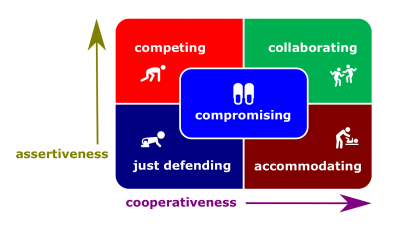Difference between revisions of "Conflict intention"
(Created page with "400px|thumb|right|[[Conflict intentions]]Conflict intention (hereinafter, the ''Intention'') is one's aim, plan, or intention for confli...") |
(→Related coursework) |
||
| Line 8: | Line 8: | ||
*[[Defending intent]]. The intention of a party of a [[conflict]] to withdraw from a [[conflict]] and [[defensive behavior|behave defensively]] without [[competing]], [[collaborating]], [[accommodating]], and/or [[compromising]]. | *[[Defending intent]]. The intention of a party of a [[conflict]] to withdraw from a [[conflict]] and [[defensive behavior|behave defensively]] without [[competing]], [[collaborating]], [[accommodating]], and/or [[compromising]]. | ||
| − | ==Related | + | ==Related lectures== |
*[[Social Rationale Quarter]]. | *[[Social Rationale Quarter]]. | ||
[[Category: Septem Artes Administrativi]][[Category: Articles]] | [[Category: Septem Artes Administrativi]][[Category: Articles]] | ||
Latest revision as of 17:27, 4 January 2019
Conflict intention (hereinafter, the Intention) is one's aim, plan, or intention for conflict process and its outcomes.
Types
- Collaborating intent. The intention of a party of a conflict to satisfy fully the concerns of all parties.
- Competing intent. The intention of a party of a conflict to satisfy own interests, regardless of the impact on the other party of the conflict.
- Compromising intent. The intention of a party of a conflict to give up something in order to gain something instead.
- Accommodating intent. The intention of a party of a conflict to place the opponent's interests above his or her own.
- Defending intent. The intention of a party of a conflict to withdraw from a conflict and behave defensively without competing, collaborating, accommodating, and/or compromising.
